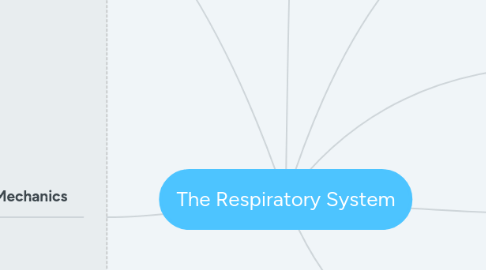
1. Organs
1.1. Nose
1.1.1. External portion
1.1.1.1. bony framework
1.1.1.2. cartilageous framework
1.1.2. Internal portion
1.1.2.1. Nasal septum
1.1.2.2. nasal cavity
1.2. Pharynx
1.2.1. Functions
1.2.2. Divided into 3 parts:
1.2.2.1. Nasopharynx
1.2.2.2. Oropharynx
1.2.2.3. Laryngopharynx
1.3. Larynx
1.3.1. Function
1.3.2. Voice box
1.3.2.1. Vocal cords
1.3.3. Composed of cartilage (4)
1.3.4. Glottis
1.4. Trachea
1.4.1. Structure
1.4.2. Location
1.5. Bronchi
1.5.1. Structural changes with branching
1.5.2. Branching of the bonchial tree (5):
1.5.2.1. main bronchi
1.5.2.1.1. lobar bronchi
1.6. Lungs
1.6.1. Functionally
1.6.2. Structurally
1.6.3. pleural membrane
1.7. Alveoli
2. Respiratory Mechanics
2.1. Pulmonary ventilation
2.1.1. What is the 2 phases of it?
2.1.2. what are the muscles of breathingm during inhalation and the expiration?
2.1.3. what is the relation between volume and pressure? what is the rule that confirm it?
2.1.3.1. what forces allow air to inter and exite the lungs? ( the cause of inhalation and expiration)?
2.1.3.2. How can we change the lung pressure?
2.1.3.3. How can we change the lung volume?
2.1.4. Describe breathing muscles' actions during both inhalation and expiration?
2.1.5. ..................The breathing air flow..............
2.1.5.1. what is important about the earth atmosphere?
2.1.5.2. What is the 4 factors that affect the airflow? what is the main factor?
2.1.5.3. What is the transpulmonary pressure at rest? how to calculate it?
2.1.5.4. What are the 4 pulmonary pressures? Explain?
2.1.5.5. What did the inhalation active process involves?
2.1.5.5.1. Related sequences?
2.1.5.6. What did the Expiring passive process involves?
2.1.5.6.1. Related sequences?
2.1.5.7. Give me the pressure changes between inhalation and exhalation?
2.1.6. How can we clinically assess the pulmonary ventilation (breathing)? using.... ? what is the benifits of this machine?
2.1.7. Explain the second factor that affect the air flow during ventilation (breathing)?
2.1.7.1. Explain the third factor that affect the air flow during ventilation (breathing)?
2.1.7.1.1. Explain the fourth factor that affect the airflow during ventilation (breathing)?
2.1.8. Lung volume and capacities related definitions:
2.1.8.1. Spirometer (respirometer)
2.1.8.1.1. Respiratory rate (RR)
2.1.8.2. Tidal volume (Tv)
2.1.8.2.1. Inspiratory reserve volume (IRV)
2.1.8.3. Inspiratory capacity + calculate it
2.1.8.3.1. Functional residual capacity (FRC) + calculate it
2.2. External respiration & Internal respiration
2.2.1. What is the 3 types of dead space?
2.2.2. Explain the Dalton's law?
2.2.3. What is the difference between minute and alveolar ventilation? how we calculate them?
2.2.3.1. What is an effective way to increase alveolar ventilation? Is it the rapid shallow breathing rate?
2.2.4. What is the 2 rspiration process?
2.2.4.1. External respiration (pulmonary gas exchange)
2.2.4.1.1. Define the respiratory membrane? ابدا من 13
2.2.4.1.2. How does O2 and CO2 will be exchanged between the alveoli and the blood capillary ? 17
2.2.4.1.3. Explain the process of ventilation-perfusion coupling? (18) كمية الهوا و كمية الدم
2.2.4.2. Internal respiration (systemic gas exchange)
2.2.4.2.1. How do O2 and CO2 will be exchanged between the blood capillary and the systemic cell? 21
2.2.4.3. List 4 factors affecting pulmonary and systemic gas exchange?
2.2.5. Compare between O2 and CO2 in the inhaled and expired air ?
2.2.5.1. Solution: The Inhaled: O2= 20.9 , CO2= 0.04 The Exhaled: O2= 15.9 , CO2= 3.6
2.2.6. What is Henry's Law abou?
2.2.6.1. Which one has high soluability in blood plasma? O2 or CO2 ?
2.2.6.1.1. When did the gas ability to stay in a solution will be high?...2 factors....
2.2.7. (O2 and CO2) exchang occurs via passive diffusion (gasses flow down the concentration gradient==The net movement of material from an area of high concentration to an area of lower concentration)
2.2.7.1. Explain the partial pressure gradient role in O2 and CO2 exchange? شرح سلايدات 11 و 12
